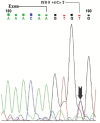Wilms' tumour 1 gene mutations in south Indian children with steroid-resistant nephrotic syndrome
- PMID: 27934809
- PMCID: PMC5206881
- DOI: 10.4103/0971-5916.195044
Wilms' tumour 1 gene mutations in south Indian children with steroid-resistant nephrotic syndrome
Abstract
Background & objectives: Clinically, nephrotic syndrome (NS) is a diverse group of symptoms; about 20 per cent of NS cases are resistant to steroid treatment, and within ten years they progress to end-stage renal disease. The present study was undertaken to identify the mutations of Wilms' tumour 1 (WT1) gene in steroid-resistant NS (SRNS) children.
Methods: A total of 173 children with SRNS and 100 children in the control group were enrolled in the study. DNA extraction was done, screened for WT1 (exons 8 and 9) gene amplified by polymerase chain reaction and direct sequencing. Karyotype analyses were done for WT1 mutation cases.
Results: WT1 mutations were found in three of 173 SRNS cases (2 girls, 1 boy). All of them had intron 9 (IVS 9 + 4 C>T, 2; IVS + 5 G>A, 1) mutation. Of these three cases, one had familial and another two had sporadic history. Renal histology analysis showed two cases with focal segmental glomerulosclerosis (FSGS) and they had external female genitalia but 46,XY karyotype. Both of them had streak gonads. Of the three cases, one expired.
Interpretation & conclusions: The findings of the present study indicate that all females with SRNS-FSGS should be screened for WT1 gene mutation to diagnose whether they have FS for possible gonadectomy.
Figures
References
-
- Bagga A, Mantan M. Nephrotic syndrome in children. Indian J Med Res. 2005;122:13–28. - PubMed
-
- Hogg RJ, Portman RJ, Milliner D, Lemley KV, Eddy A, Ingelfinger J. Evaluation and management of proteinuria and nephrotic syndrome in children: recommendations from a pediatric nephrology panel established at the National Kidney Foundation conference on proteinuria, albuminuria, risk, assessment, detection, and elimination (PARADE) Pediatrics. 2000;105:1242–9. - PubMed
-
- Hinkes BG, Mucha B, Vlangos CN, Gbadegesin R, Liu J, Hasselbacher K, et al. Nephrotic syndrome in the first year of life: two thirds of cases are caused by mutations in 4 genes (NPHS1, NPHS2, WT1, and LAMB2) Pediatrics. 2007;119:e907–19. - PubMed
-
- Mbarek IB, Abroug S, Omezzine A, Pawtowski A, Gubler MC, Bouslama A, et al. Novel mutations in steroid-resistant nephrotic syndrome diagnosed in Tunisian children. Pediatr Nephrol. 2011;26:241–9. - PubMed
-
- Choudhry S, Bagga A, Hari P, Sharma S, Kalaivani M, Dinda A. Efficacy and safety of tacrolimus versus cyclosporine in children with steroid-resistant nephrotic syndrome: a randomized controlled trial. Am J Kidney Dis. 2009;53:760–9. - PubMed
MeSH terms
Substances
LinkOut - more resources
Full Text Sources
Other Literature Sources
Miscellaneous

